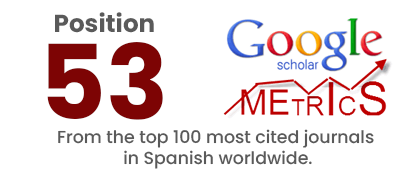La técnica queiloscópica de Tsuchihashi -Suzuki en los alumnos de la universidad Norbert Wiener-2019
DOI:
https://doi.org/10.36097/rsan.v1i55.2232Keywords:
odontología forense, huellas labiales, identificación humana, queiloscópica, Tsuchihashi – Suzuki.Abstract
El presente estudio tuvo como objetivo determinar la relación entre las impresiones labiales y el género mediante la técnica queiloscópica de Tsuchihashi -Suzuki en alumnos de primer y segundo ciclo de la Escuela de Odontología de la Universidad Norbert Wiener. Su importancia radicó en profundizar las técnicas de identificación humana, la aplicación y vinculación con la práctica será de gran interés puesto que se basa en proporcionar conocimientos valiosos que contribuyen a la odontología forense. La investigación fue de tipo descriptivo-relacional de corte transversal. Los resultados basados en el análisis del patrón labial y el género en los estudiantes se apreció asociación en los patrones labial superior derecho e izquierdo con mayor predominio el tipo III y tipo II y en los patrones labial inferior derecho e izquierdo mayor predominio el tipo II y III. Se concluye que la clasificación de los cuadrantes de la técnica queiloscópica de Tsuchihashi -Suzuki permite un estudio veraz en cuanto a la relación entre las impresiones labiales y el género.
Downloads
References
Ahmed, S. A., Salem, H. E., & Fawzy, M. M. (2018). Forensic dissection of lip print as an investigative tool in a mixed Egyptian population. Alexandria Journal of Medicine, 54(3), 235-239. https://doi.org/10.1016/j.ajme.2017.08.002
Bécue, A., Eldridge, H., & Champod, C. (2020). Interpol review of fingermarks and other body impressions 2016–2019. Forensic Science International: Synergy, 2, 442-480. https://doi.org/10.1016/j.fsisyn.2020.01.013
Carvajal Oviedo, H., Donaire Alcocer, P., Vaca Paredes, R., Da Silva, R.., & Navarro Sandoval, M. (2014). Patrón queiloscópico de la población entre 21 y 59 años, en el Centro de Salud Materno Infantil de Tembladerani de la ciudad de La Paz: Protocolo para la toma de muestras queiloscópicas. Revista Científica Visión Dental, 23(2), 17 - 27. https://cientifica.visiondental.pe/index.php/vision/article/view/25
Doroz, R., Wrobel, K., Orczyk, T., Porwik, P., & Cholewa, M. (2022). Multidimensional nearest neighbors classification based system for incomplete lip print identification. Expert Systems with Applications, 202, 117-137. https://doi.org/10.1016/j.eswa.2022.117137
Downs, J. C. U., & E. Barsley, R. (2018). Ethical Issues in Forensic Science & Forensic Odontology. En T. J. David y J. M. Lewis (Eds.). Forensic Odontology (pp. 241-273). Elsevier. https://doi.org/10.1016/B978-0-12-805198-6.00013-X
Fonseca, G. M., Ortíz-Contreras, J., Ramírez-Lagos, C., & López-Lázaro, S. (2019). Lip print identification: Current perspectives. Journal of Forensic and Legal Medicine, 65, 32-38. https://doi.org/10.1016/j.jflm.2019.04.009
Jani, G., Johnson, A., Marques, J., & Franco, A. (2021). Three-dimensional(3D) printing in forensic science–An emerging technology in India. Annals of 3D Printed Medicine, 1. https://doi.org/10.1016/j.stlm.2021.100006
Johnson, A., Jani, G., Carew, R., & Pandey, A. (2021). Assessment of the accuracy of 3D printed teeth by various 3D printers in forensic odontology. Forensic Science International, 328, 111044. https://doi.org/10.1016/j.forsciint.2021.111044
Kapoor, N., & Badiye, A. (2017). A study of distribution, sex differences and stability of lip print patterns in an Indian population. Saudi Journal of Biological Sciences, 24(6), 1149-1154. https://doi.org/10.1016/j.sjbs.2015.01.014
Khanagar, S. B., Vishwanathaiah, S., Naik, S., A. Al-Kheraif, A., Devang Divakar, D., Sarode, S. C., Bhandi, S., & Patil, S. (2021). Application and performance of artificial intelligence technology in forensic odontology – A systematic review. Legal Medicine, 48. https://doi.org/10.1016/j.legalmed.2020.101826
Komuro, T., Tsutsumi, H., Izawa, H., Katsumura, S., Saitoh, H., Sakurada, K., Sato, K., & Furukawa, A. (2019). Social contribution of forensic odontology in Japan. Japanese Dental Science Review, 55(1), 121-125. https://doi.org/10.1016/j.jdsr.2019.09.003
Mânica, S., & Gorza, L. (2019). Forensic odontology in the 21st century – Identifying the opinions of those behind the teaching. Journal of Forensic and Legal Medicine, 64, 7-13. https://doi.org/10.1016/j.jflm.2019.03.006
Matsuda, S., Yoshida, H., Ebata, K., Shimada, I., & Yoshimura, H. (2020). Forensic odontology with digital technologies: A systematic review. Journal of Forensic and Legal Medicine, 74. https://doi.org/10.1016/j.jflm.2020.102004
Navami, D., Basavaraj, R. B., Sharma, S. C., Daruka Prasad, B., & Nagabhushana, H. (2018). Rapid identification of latent fingerprints, security ink and WLED applications of CaZrO3:Eu3+ fluorescent labelling agent fabricated via bio-template assisted combustion route. Journal of Alloys and Compounds, 762, 763-779. https://doi.org/10.1016/j.jallcom.2018.05.016
Sakhavalkar, P., & Salpekar, P. (2017). Cheiloscopy and rugoscopy: Role in forensic odontology. Lambert Academic Publishing.
Silva-Sousa, A. C., Marañón-Vásquez, G. A., Gerber, J. T., Judachesci, C. S., Stuani, M. B. S., Nakane Matsumoto, M. A., Coletta, R. D., Scariot, R., & Küchler, E. C. (2020). Left-right asymmetry in palatal rugae is associated with genetic variants in WNT signaling pathway. Archives of Oral Biology, 110. https://doi.org/10.1016/j.archoralbio.2019.104604
Suresh, C., Nagabhushana, H., Darshan, G. P., Basavaraj, R. B., Kavyashree, D., Sharma, S. C., Arulmozhi, A., Daruka Prasad, B., & Amith Yadav, H. J. (2018). Facile LaOF: Sm 3+ based labeling agent and their applications in residue chemistry of latent fingerprint and cheiloscopy under UV–visible light. Arabian Journal of Chemistry, 11(4), 460-482. https://doi.org/10.1016/j.arabjc.2017.09.014
Suzuki, K., & Tsuchiahashi, Y. (1971). A new Attempt of Personal Identification by Means of Lip Print. Canadian Society of Forensic Science Journal, 4(4), 154-158. https://doi.org/10.1080/00085030.1971.10757287
Wrobel, K., Doroz, R., Porwik, P., Naruniec, J., & Kowalski, M. (2017). Using a Probabilistic Neural Network for lip-based biometric verification. Engineering Applications of Artificial Intelligence, 64, 112-127. https://doi.org/10.1016/j.engappai.2017.06.003
Zhang, X., Luo, Q., Shangguan, H., Wu, Y., Li, B., & Yang, J. (2021). Three-dimensional palatal rugae recognition based on cyclic spectral analysis. Biomedical Signal Processing and Control, 68. https://doi.org/10.1016/j.bspc.2021.102718
Downloads
Published
How to Cite
Issue
Section
License
Copyright (c) 2023 Revista San Gregorio

This work is licensed under a Creative Commons Attribution-NonCommercial-NoDerivatives 4.0 International License.


















